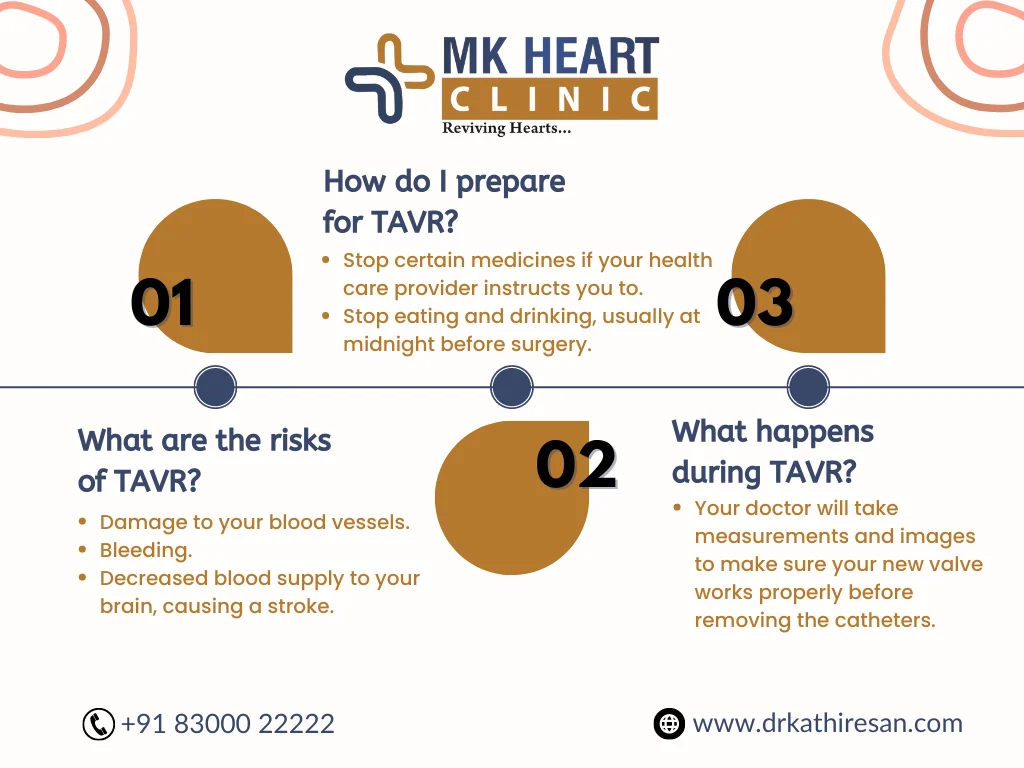TAVR or Transcatheter Aortic Valve Replacement is a non-surgical, minimally invasive procedure that is performed by a cardiologist to treat aortic valve stenosis (one type of aortic valve disease). It is also known as TAVI or Transcatheter Aortic Valve Implantation.
Usually, for any individual when the blood exits the heart, it will pass through the aortic valve. But in patients with aortic stenosis, the valve gets stiff and narrow and neither opens nor closes as it should. This makes it harder for the heart to pump blood to the human body. As a result, patients will feel shortness of breath and fatigued and are at high risk for a stroke or a Heart Attack.
What is TAVR?
The only treatment for aortic valve stenosis is replacing the valve using a traditional approach, open-heart surgery. However, Transcatheter Aortic Valve Replacement is an alternative method that is equally effective and much less invasive acting as a boon for many patients.
The reason is that, instead of opening the chest to remove and replace the damaged valve, the physician threads a catheter (a thin, flexible tube) through a blood vessel to reach the heart, then inserts a new valve inside of the faulty one, restoring healthy blood flow. The Transcatheter Aortic Valve Implantation or TAVI procedure takes much less time than open-heart surgery, and patients recover more quickly, with less pain and scarring.
Why TAVR is Performed?
Your doctor may recommend Transcatheter Aortic Valve Implantation or TAVI surgery if you have:
Severe aortic stenosis causes signs and symptoms like irregular heartbeat, angina or chest pain, dizziness, shortness of breath, fatigue, palpitations, inability to eat enough, and inability to gain enough weight.
A biological tissue aortic valve that isn’t working normally as it should. Another health condition, such as kidney or lung disease, makes open-heart valve replacement surgery too risky.

Importance of TAVR
Transcatheter Aortic Valve Implantation or TAVI has delivered excellent patient outcomes. Some eye-opening statistics of this procedure are that,
- Patients who have undergone the TAVI surgery have experienced 99.2 %relief from disabling stroke within just 30 days after the procedure.
- Survival rates have increased to 98.4%after just 30 days of undergoing the TAVI procedure.
Diagnostic Tests
To perform the Transcatheter Aortic Valve Implantation or TAVI procedure, the doctor may perform certain diagnostic tests like :
- Echocardiogram
- Electrocardiogram (ECG or EKG)
- Chest X-ray.
- Cardiac magnetic resonance imaging (MRI) scan
- Cardiac computerized tomography (CT) scan
- Exercise tests or stress tests
- Cardiac catheterization
Surgical Procedure
In Transcatheter Aortic Valve Implantation, the delivery sheath is inserted through a catheter by way of the femoral artery in the patient’s groin or chest area. In most cases, only a small incision is made. Then, the TAVI valve is pushed upwards through the artery until it reaches the aortic valve.
After the new valve replacement, it expands by pushing the old valve leaflets out of the way with the new tissue systematically in the replacement valve regulating the blood flow. The new valve either expands by itself or is expanded using the balloon catheter, depending on the type of valve used. The new valve is positioned to push aside the damaged aortic valve. Finally, the balloon is deflated, and the small incisions in the groin or chest area are sealed.
Preparing for Transcatheter Aortic Valve Implantation (TAVI): A Brief Guide
Preparing for a Transcatheter Aortic Valve Implantation (TAVI) involves several key steps to ensure a smooth and successful procedure:
- Medical Evaluation: Undergo a thorough medical evaluation to assess your overall health and suitability for the TAVI procedure.
- Diagnostic Tests: Complete necessary diagnostic tests, including imaging and blood tests, to provide detailed information to your healthcare team.
- Discussion with the Heart Team: Engage in discussions with your heart team, including cardiologists and cardiac surgeons, to understand the procedure, potential risks, and expected outcomes.
- Medication Review: Review your current medications with your healthcare team, and make any necessary adjustments before the procedure.
- Nutritional Guidance: Follow any nutritional guidelines provided by yfour healthcare team to optimize your health before the TAVI procedure.
- Preoperative Instructions: Receive specific preoperative instructions, including fasting guidelines and any required lifestyle modifications.
- Emotional Preparation: Prepare emotionally for the procedure by addressing any concerns or questions with your healthcare providers.
Remember, open communication with your healthcare team and adherence to their guidance are essential for a successful TAVI procedure. Always consult with your medical professionals for personalized advice based on your unique health situation.
Recovery Period
In most cases, patients who have undergone Transcatheter Aortic Valve Implantation will be kept in the intensive care unit until he/she recovers. It takes about 1 – 2 days for monitoring. Following that, the patients will be shifted to another unit where their recovery will be closely monitored for over a week. Full recovery takes up to 2 months, after which they can return to their day-to-day activities.
Benefits of Transcatheter Aortic Valve Implantation
Transcatheter Aortic Valve Implantation or TAVI surgery has several advantages compared to surgery, which is why it has become the most common method for replacing the aortic valve. The importance of TAVR includes:
- Less invasive than surgery
- Speedy recovery
- Minimal hospital stays
- Better outcomes
- Higher survival rate
Complications of TAVI
Depending on a patient’s medical condition, there are fewer chances of risk after the Transcatheter Aortic Valve Implantation. Some of the rare risks of TAVI include:
- Damage to the blood vessels.
- Collection of fluid around your heart.
- Decreased blood supply to the brain, causing a stroke.
- Severe Bleeding
- Heart attack.
- Kidney failure.
- Leakage in the replacement valve.
- Severe Heart Failure.
- Death.
It is always advisable to consult with the doctor before the procedure so that you can avoid these types of risks in the future.
Conclusion
At MK Heart Clinic, our multi-disciplinary team of cardiologists, cardiothoracic surgeons, geriatricians, anesthetists, radiologists, physiotherapists, nursing staff, intensive care specialists, and other support staff to successfully perform the advanced Transcatheter Aortic Valve Implantation using the state-of-the-art equipment to ensure excellent results for our patients.



